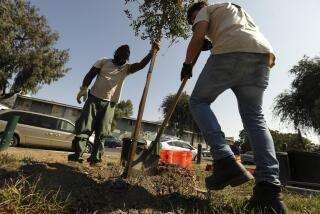A Supermarket Grows in Orange : Development: Landmark ficus tree appears on its way out of historic sit to make room for Lucky store expansion. Preservationists protest, but economics may force City Council’s hand.
ORANGE — In the neighborhood, it’s called “the Lucky’s Market Tree.” But the well-known Orange landmark, planted more than 80 years ago by members of the Flippen family in front of their home, may soon be needing a new patch of ground in which to spread its roots.
The 60-foot-tall tree stands squarely in the path of a planned expansion of a Lucky grocery store. And it has become the object of an all-too-familiar Southern California battle that pits a piece of local history against growth and commercial development.
But last month, Lucky Stores approached the Orange City Council for permission to move the tree to a new location, saying they would pick up the estimated $100,000 cost of the tree transfer.
Council members postponed a decision till Tuesday, saying they need more information about how the tree would be moved. Lucky’s officials warned, however, that if they don’t receive permission to move the ficus, they might relocate the supermarket.
“The facility needs to be upgraded to remain viable on a long-term basis,” said Dave Weigel, a vice president of real estate for Lucky. “We’d like to stay in the community and expand and remodel.”
But Orange preservationists are rallying around the approximately 80-year-old ficus tree. It is all that remains of the historic Flippen homestead, which was replaced by a shopping center that includes the Lucky at 2620 E. Chapman Ave.
Some in Orange, whose residents are known for their fierce battles over historic preservation, say Lucky just isn’t approaching the tree dilemma with the right attitude.
“Obviously, that tree’s been there longer than Lucky’s store,” said Councilwoman Joanne Coontz. “I would think creativity (by Lucky) could easily come into play.”
Adds Alice Clark, a longtime resident and property rights advocate: “I do feel for business but I have a lot of doubts about moving that big old tree.”
Economics seems to be the imperative for Lucky officials, who said that at 31,000 square feet, the Orange Lucky is no longer competitive; sales have fallen in the past several years as larger grocery stores have sprung up nearby.
“The typical stores we’re building are now 45,000 to 50,000 square feet and they contain all the full services departments,” said Judie Decker, a Lucky spokeswoman, adding that this Lucky is too small to offer such conveniences as a fresh deli counter.
Some council members have indicated they would be amenable to a compromise, saying they feared losing sales tax revenue from the store if it shuts down or continues to lose business.
“I’m really big on trees but I think there has to be an accommodation here,” said Councilman Mike Spurgeon.
The city receives 1% in sales tax on taxable goods sold at the market, about 30% of all the store’s sales, said Lucky officials. Neither the city nor Lucky would release the taxes generated by the market annually.
But even if the council approves moving the tree, the battle will be far from over.
Lucky does not own the property and will expand the store only if it can buy the land. It is currently negotiating the purchase.
Moving the tree is “something we wanted to look at. If we are considering buying and rebuilding the center, we need to address the issue of the tree. If we rebuild, it will have to be moved,” Decker said.
Lucky officials pointed out that they aren’t planning to send the historic tree to the nearest paper mill. They’ve hired the Valley Crest Tree Co. of San Fernando to move it, although to where is unknown since no site has been secured.
“We are very comfortable that this tree can be moved and be around in 10 or 20 or 30 years,” said John Mote of Valley Crest. “We’ve been in business over 40 years and we’ve moved over a thousand ficus trees. (They) move with a great degree of success.”
But opponents say Lucky should expand in another direction on the property or incorporate the tree into the store’s redesign.
“If they stop thinking of right angles maybe they could save that tree,” said Bea Herbst, a board member of the Tree Society of Orange County. “I can’t understand why Lucky’s can’t make it into a focal point and attraction. If it’s near the front entry, why not put in an eating spot?”
That’s unlikely, said market officials.
“I’ve never seen a tree in a building with a hole in the roof,” Weigel said. “It’s not feasible to build around a tree.”
For now, the ficus tree is visible from Chapman Avenue. It spreads its branches about 40 feet from the side of the market, and several cars can park in the shade it provides. Through its many branches, consumers can see the sign advertising “Over 2500 New Lower Prices” at Lucky.
Among those expressing their opinion in the matter of the tree is John French, the city’s general services director and a direct descendant of the Flippen family.
“My own personal belief is that I would like it to remain,” French said. “I’ve polled a couple of relatives and they would prefer to keep it on the property if it has to be moved at all.”
More to Read
Sign up for Essential California
The most important California stories and recommendations in your inbox every morning.
You may occasionally receive promotional content from the Los Angeles Times.






